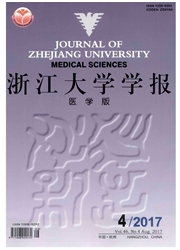

 中文摘要:
中文摘要:
目的:评价伸爪试验是否为一种客观评价小鼠局灶性脑缺血后慢性神经功能变化的方法。方法:在伸爪试验盒内,训练小鼠通过0.5cm窄缝用左侧前肢抓取食物;3周后,以右侧大脑中动脉阻塞诱导局灶性脑缺血,继续观察4周内伸爪抓取食物的成功率,并与经典的转角试验、神经症状评分和斜板试验比较。实验结束后,观察脑梗死体积及神经元密度。结果:小鼠脑缺血后,抓取食物的成功率下降,转角试验的右转百分率增加,神经症状评分增加,斜板滞留角下降。斜板滞留角在脑缺血后5d恢复,其他3个指标在4周内都有显著变化。脑缺A4周的脑梗死体积增加,皮层、海马CA1区以及纹状体神经元密度下降。结论:伸爪试验是一种客观、稳定的指标,可用于评价小鼠局灶性脑缺血后慢性神经功能变化。
 英文摘要:
英文摘要:
Objective: To determine whether the skilled reaching test is an objective method for evaluating long-term neurological deficits after focal cerebral ischemia in mice. Methods: In a reaching box,mice were trained to reach food pellets with their left forelimb through a 0. 5 cm slit for 3 weeks. Then focal cerebral ischemia was induced by occluding the right middle cerebral artery,and the percentage of success in obtaining food was observed for 4 weeks. In comparison, the neurological deficit score, the holding angle in an inclined board test, and right turns in a corner test were simultaneously performed. At the end of the experiments, brain infarcts and neuron densities were determined. Results: After focal cerebral ischemia, the percentage of success in the reaching test was reduced, the right turns in the corner test were increased, the neurological deficit score was increased, and the holding angle in the inclined board test was reduced as well. The holding angle recovered 5 d after ischemia, whereas other 3 indicators remained abnormal until 4 weeks. At the end of the experiments,the brain infarct volumes were increased, and the reduced in ischemic for evaluating long neuron densities in the cortex, hippocampal CA1 region and striatum were mice. Conclusion. The skill reaching test is an objective and stable method term neurological deficits after focal cerebral ischemia in mice.
 同期刊论文项目
同期刊论文项目
 同项目期刊论文
同项目期刊论文
 期刊信息
期刊信息
